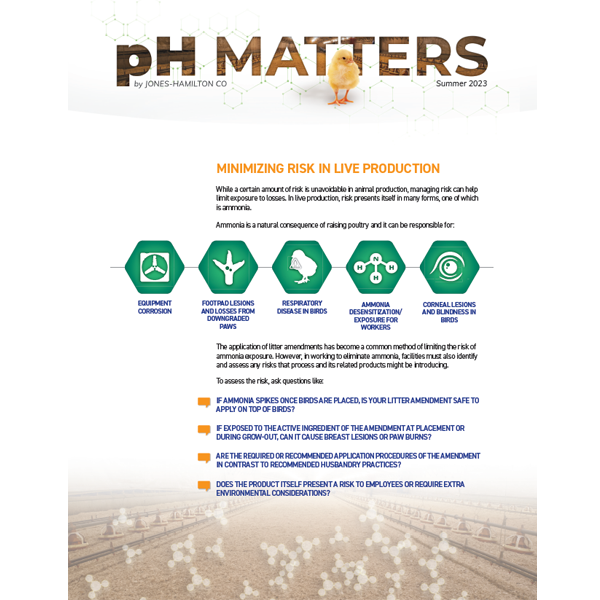Minimizing Risk in Live Production
While a certain amount of risk is unavoidable in animal production, managing risk can help limit exposure to losses. In live production, risk presents itself in many forms, one of which is ammonia.
Ammonia is a natural consequence of raising poultry and it can be responsible for:

Equipment corrosion

Footpad lesions and losses

Respiratory disease in birds

Ammonia exposure

Corneal lesions and blindness in birds
The application of litter amendments has become a common method of limiting the risk of ammonia exposure. However, in working to eliminate ammonia, facilities must also identify and assess any risks that process and its related products might be introducing.
To assess the risk, ask questions like:
- If ammonia spikes once birds are placed, is your litter amendment safe to apply on top of birds?
- If exposed to the active ingredient of the amendment at placement or during grow-out, can it cause breast lesions or paw burns?
- Are the required or recommended application procedures of the amendment in contrast to recommended husbandry practices?
- Does the product itself present a risk to employees or require extra environmental considerations?

Litter amendments that contain free sulfuric acid are classified as a Class 8 Hazard by the Department of Transportation. Not only does this present risk in the transportation and application procedures, it also limits application timing since sulfuric acid can burn skin.

PLT (sodium bisulfate) is a formulated product, not free sulfuric, so it won’t burn skin and can be applied at any time. PLT requires a hydrogen atom to activate, which it pulls in the form of water form the air or litter. This unmatched safety for people and animals is one reason the product was awarded the EPA Safer Choice designation.

When you can safely control ammonia, reduce pH to reduce the microbial action of odor-causing bacteria in litter, and maintain air quality throughout the flock, you limit exposure to conditions that can negatively impact bird performance and welfare, and worker safety.

